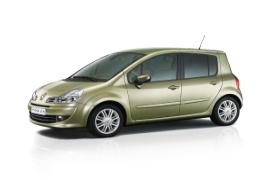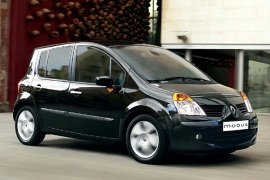RENAULT Modus Models/Series Timeline, Specifications & Photos
First production year: 2005
Engines: Gasoline, Diesel
Body style: Van
As the leading French MPV-maker, Renault didn't want to throw the towel over the Modus and refreshed it in 2008, improving its design and drivetrains.
There were just a few small-sized MPVs on the European car market in 2008, and the Modus benefited from Renault's experience in building them. Moreover, Nissan helped a bit with their expertise in the Japanese kei-car segment. But that wasn't enough to keep the Modus' engines running for a second generation, but it survived for a facelift and the world financial crisis.
With the introduction of a new Clio, Renault tried to pass on the brand awareness of its small-segment hatchback to the Modus and installed a similar pair of headlights on the front fascia. Yet, the short and steep hood didn't help too much. The carmaker installed a wide grille in the apron to cool the engine since the small vents above the bumper were not big enough. The car still had the same shape with a flat vertical liftgate at the back.
Inside, the carmaker kept the same clean design from the Modus Phase I (pre-facelift) but with improved quality. The instrument panel featured an LCD with an orange-on-black design for the speedometer, unlike its predecessor, which used a black-on-white display. Since Renault built it on top of a Clio platform, it carried over some of the buttons, gear-stick, and switches from it.
Under the hood, Renault refreshed the engine range and retired the 1.4-liter engine, which wasn't Euro 5 compliant.
Renault tried to expand its MPV range and introduced the small-sized Modus on the market in late 2004, a vehicle made for those who needed spacious cabins but a short vehicle.
The French automaker was dominating the European MPV market with its Espace and Scenic lineups but didn’t have anything to provide to those looking for a vehicle more suitable for the urban environment but with plenty of interior room. So, enter the scene the Modus. While it shared the same ideas as its larger siblings, it sat on top of a Renault Clio platform. As a result, the car could get four people on board, some luggage, and still be short enough to park in tight spots. It also shared some of the engines with its hatchback brother. Still, it showed some features that made it even more attractive than other B-segment vehicles on the European market.
At first sight, the car’s front looked like the automaker’s design team took a regular Clio 2 Phase 2 and stretched it upwards. The headlights sported a similar triangular shape, although they were taller. In the center of the grille, Renault installed its design signature called Beak-Bird, which was seen on other vehicles made by the French automaker, such as the Laguna, the Espace, or the Clio. On the bumper, the automaker added rubber protections on the corners and, underneath them, a broad lower air intake flanked by the optional round fog lamps.
From its profile, the steep windshield paved the way for the tall greenhouse. Renault offered the Modus with a panoramic glass roof, which was unique in the segment. From its profile, depending on the trim level and options, customers could get the small-sized MPV with black B-pillars, which added a nice design touch to the car. Furthermore, another rubber stripe protected the mid-section of the doors against small bumps from shopping carts. Finally, at the back, Renault installed a vertical tailgate flanked by up-mounted taillights. The wide and tall opening helped customers load and unload the trunk, which was not that big but enough for weekly shopping.
Inside, the high-mounted seats were designed for comfort, although they were unavailable with heating. To lower production costs for left- and right-hand drive versions, the automaker installed the instrument cluster in the middle of the dashboard. The center stack carried over all of its buttons and dials from its hatchback sibling, the Clio. Between the front passengers, Renault added a narrow center console that housed the gear stick. In the back, the car featured three individual seats that could slide or fold independently. While the floor was flat enough not to interfere with the middle-seated passenger’s legroom, the vehicle’s inner width was not that generous.
Under the hood, Renault installed a choice of turbo-diesel and gasoline units ranging between 66 PS (65 hp) and 113 PS (111 hp) paired with a standard five-speed manual transmission. Its front wheel independent suspension and rear torsion beam ensured customers that they could rely on the vehicle, especially in the urban environment.

